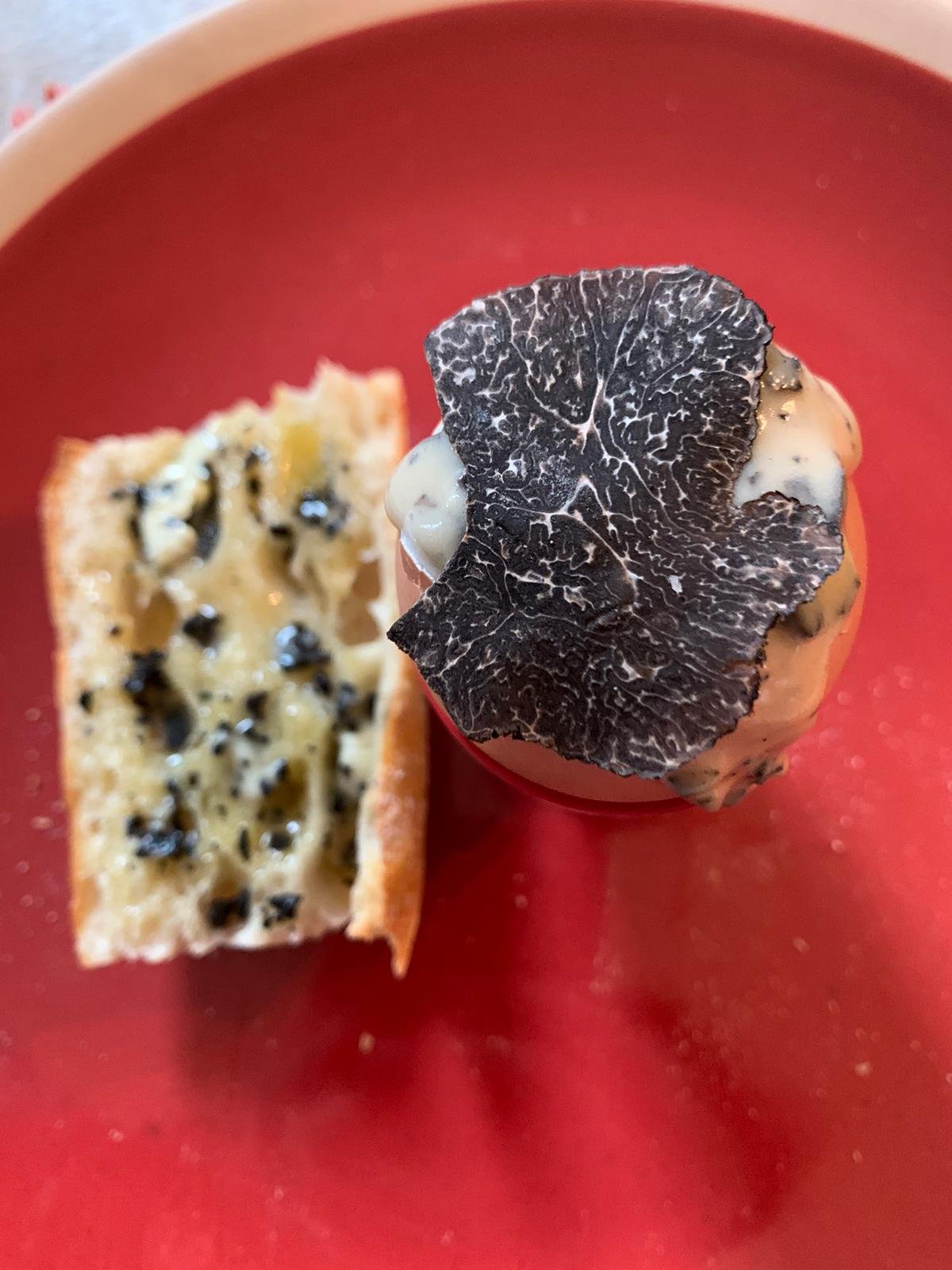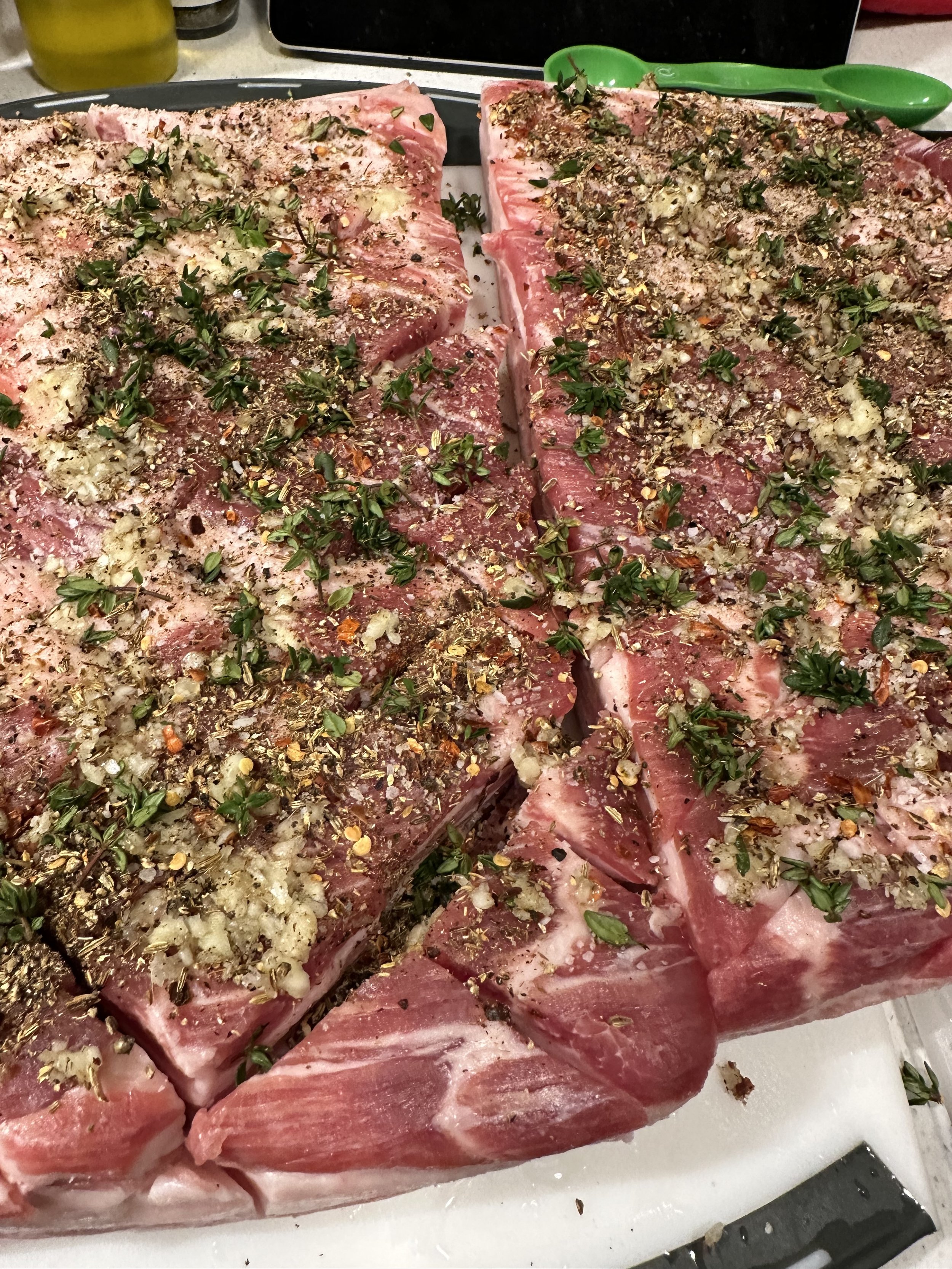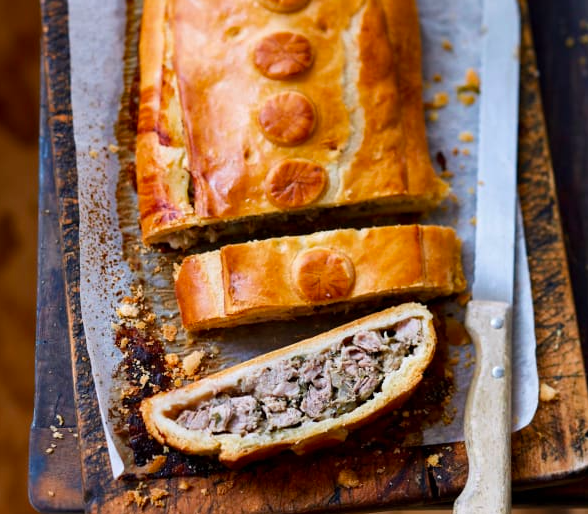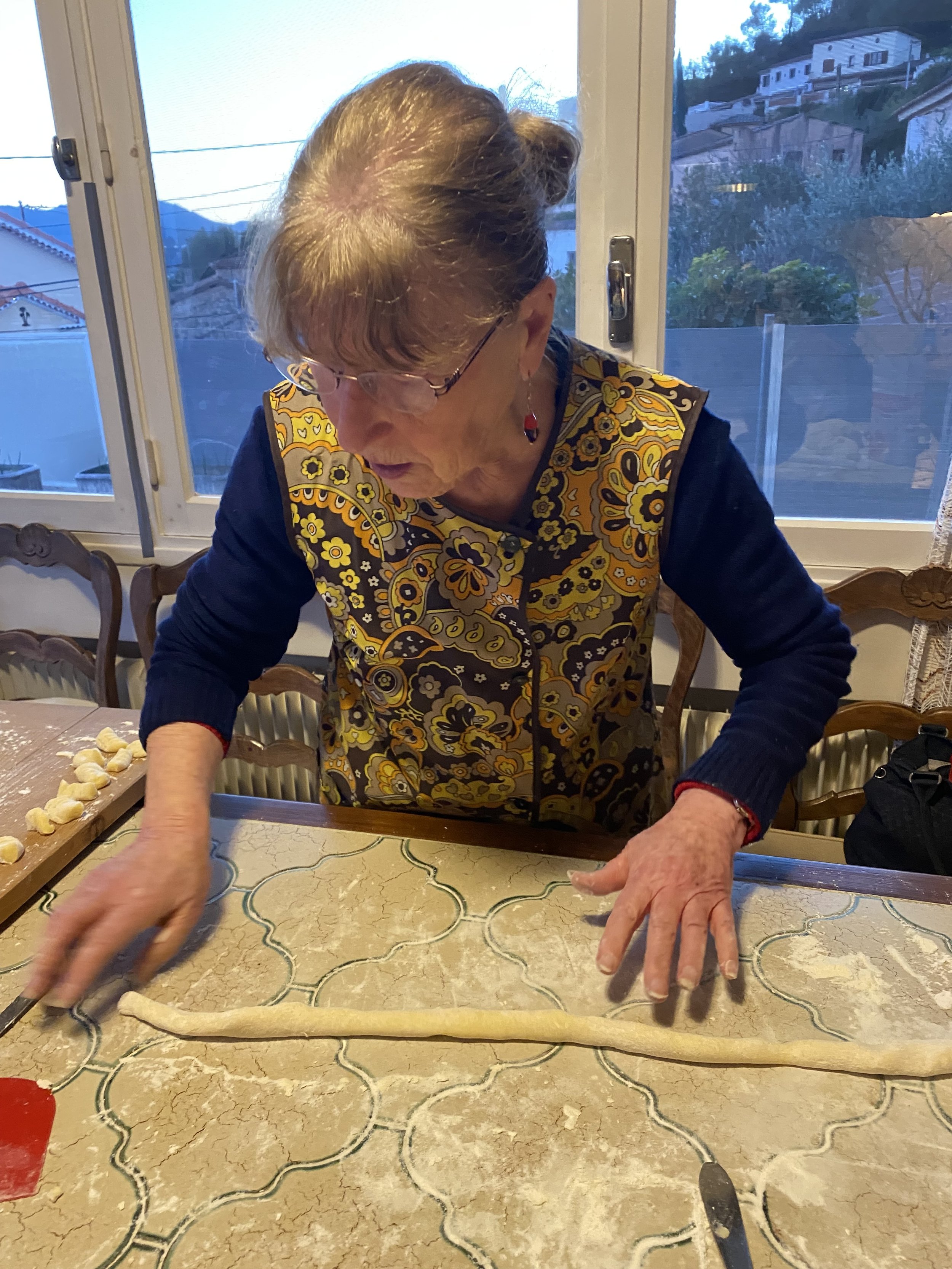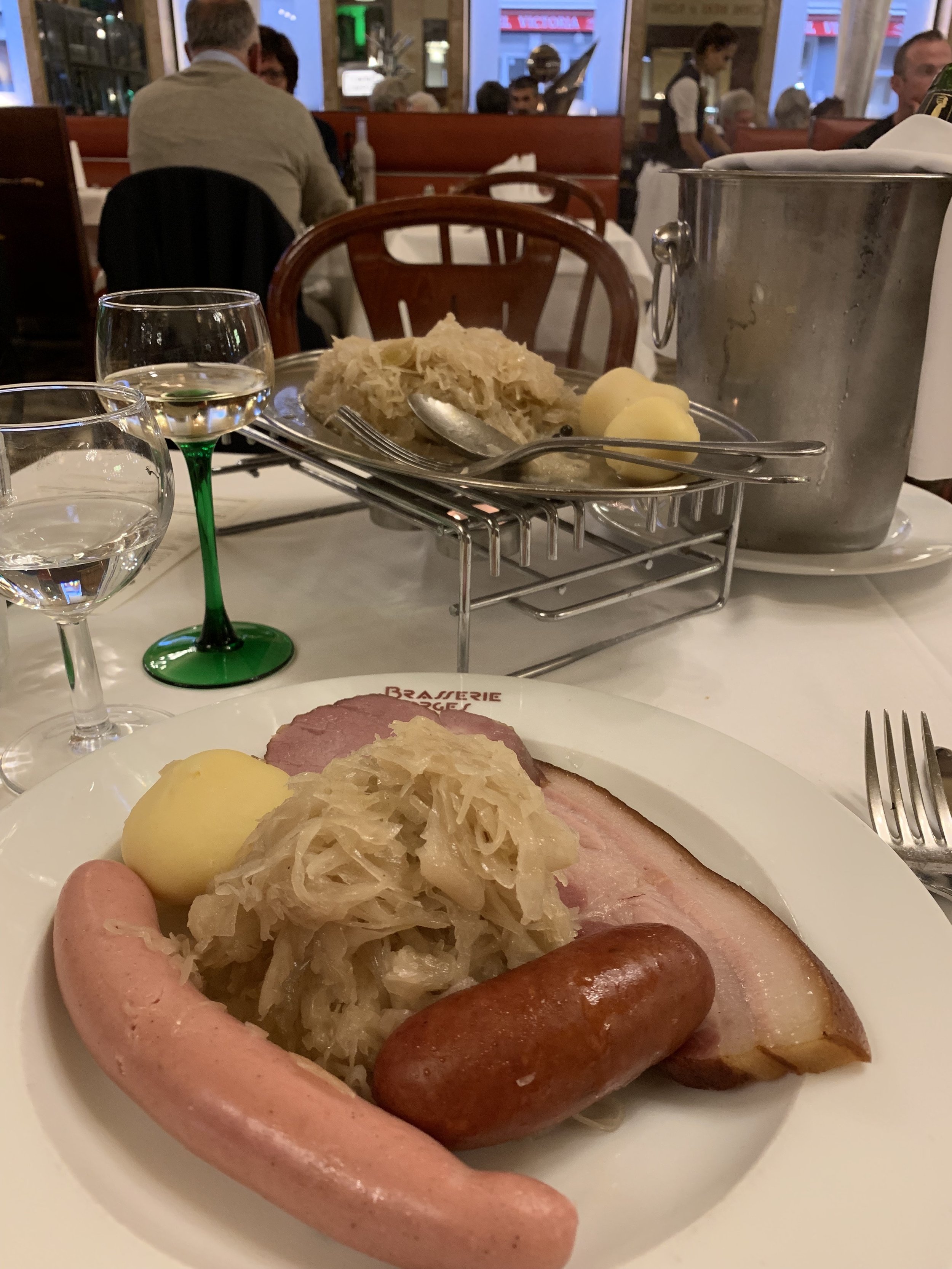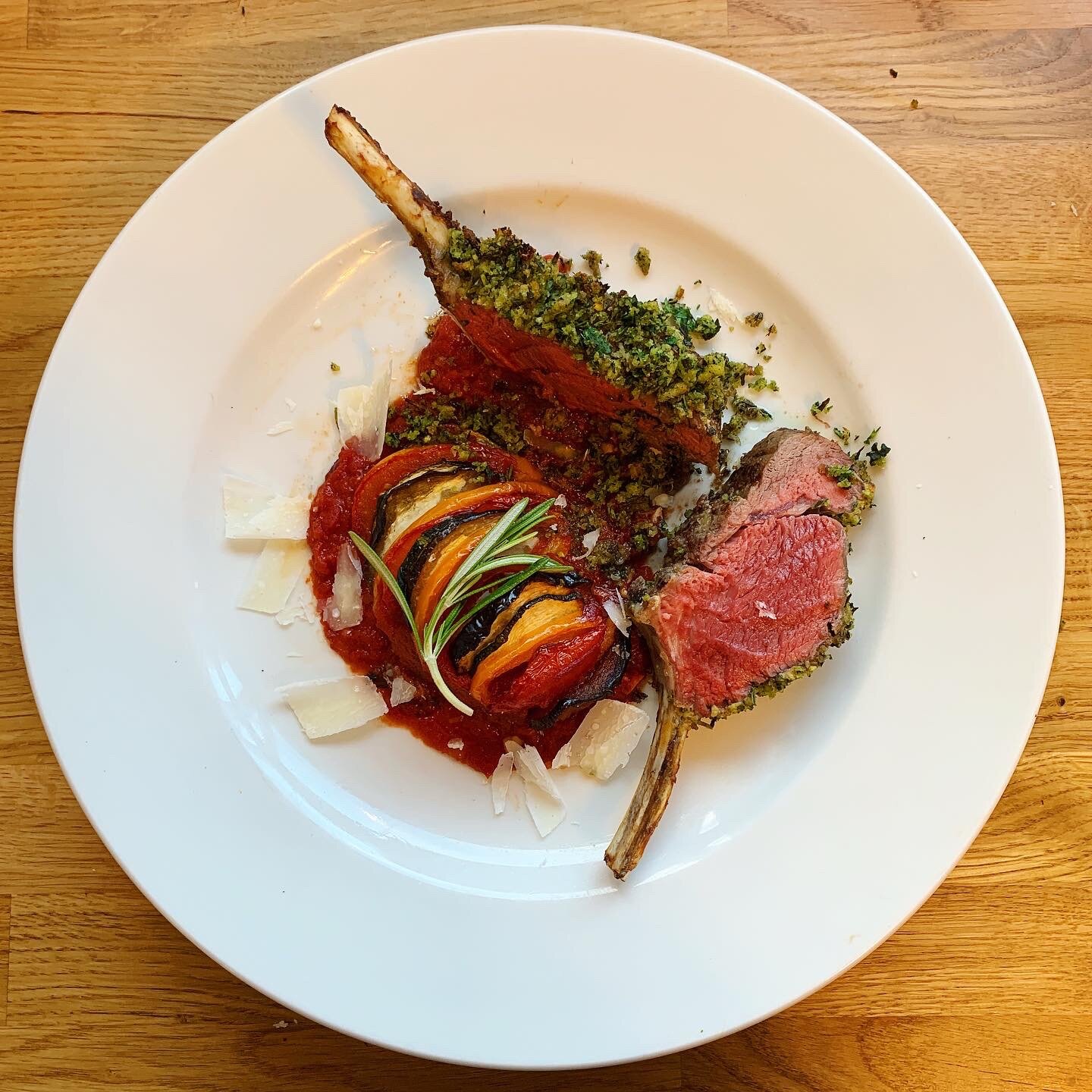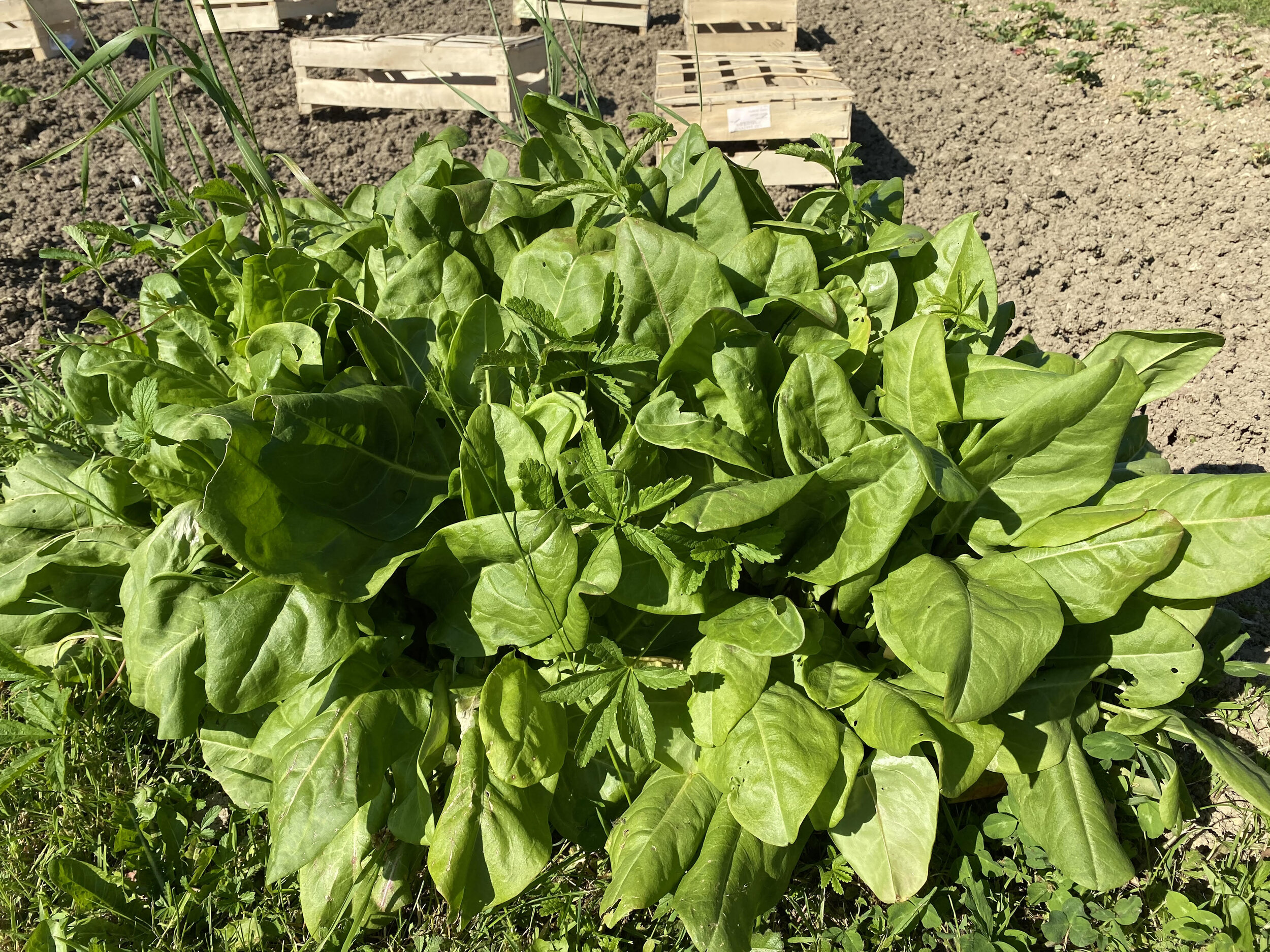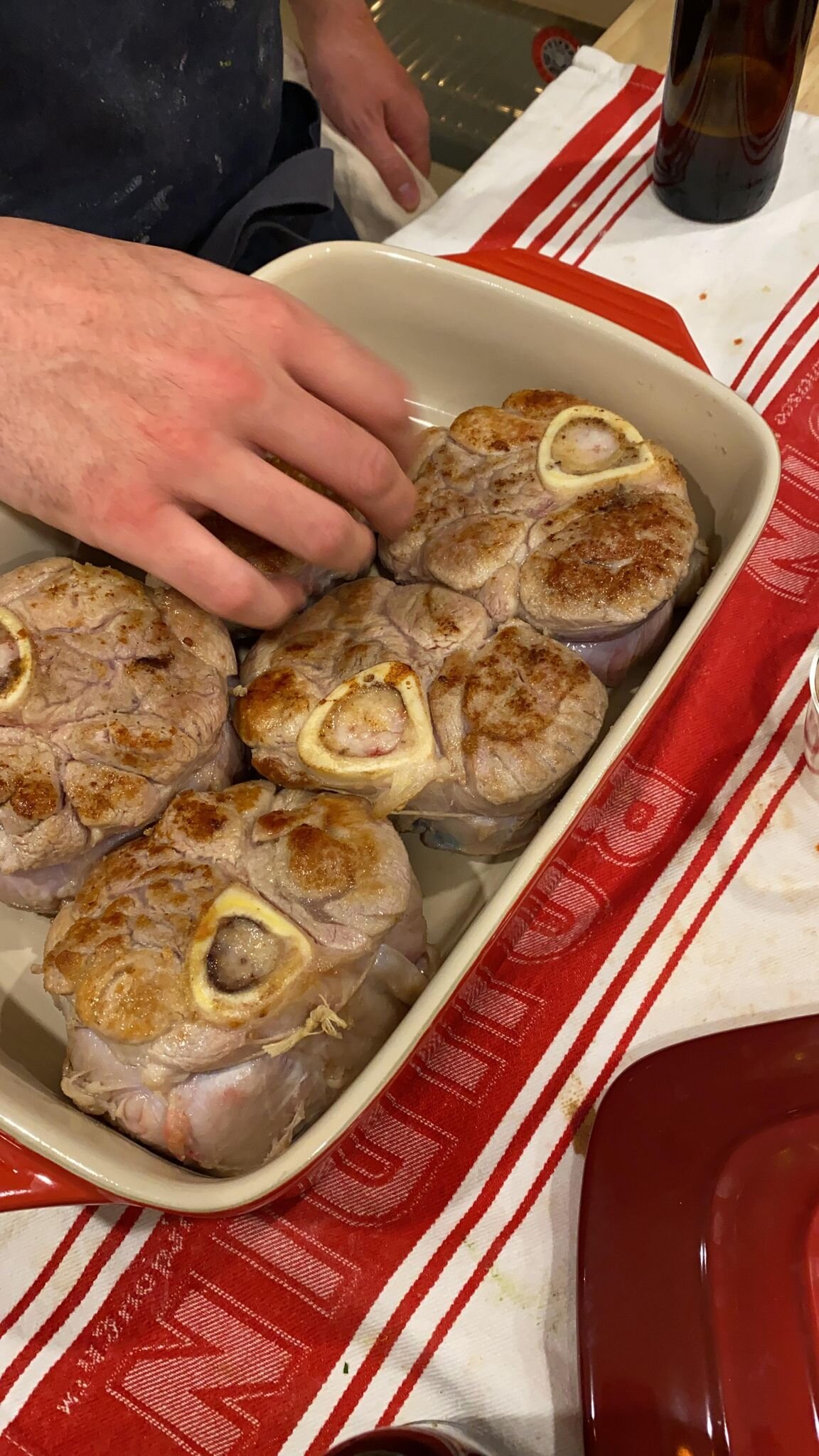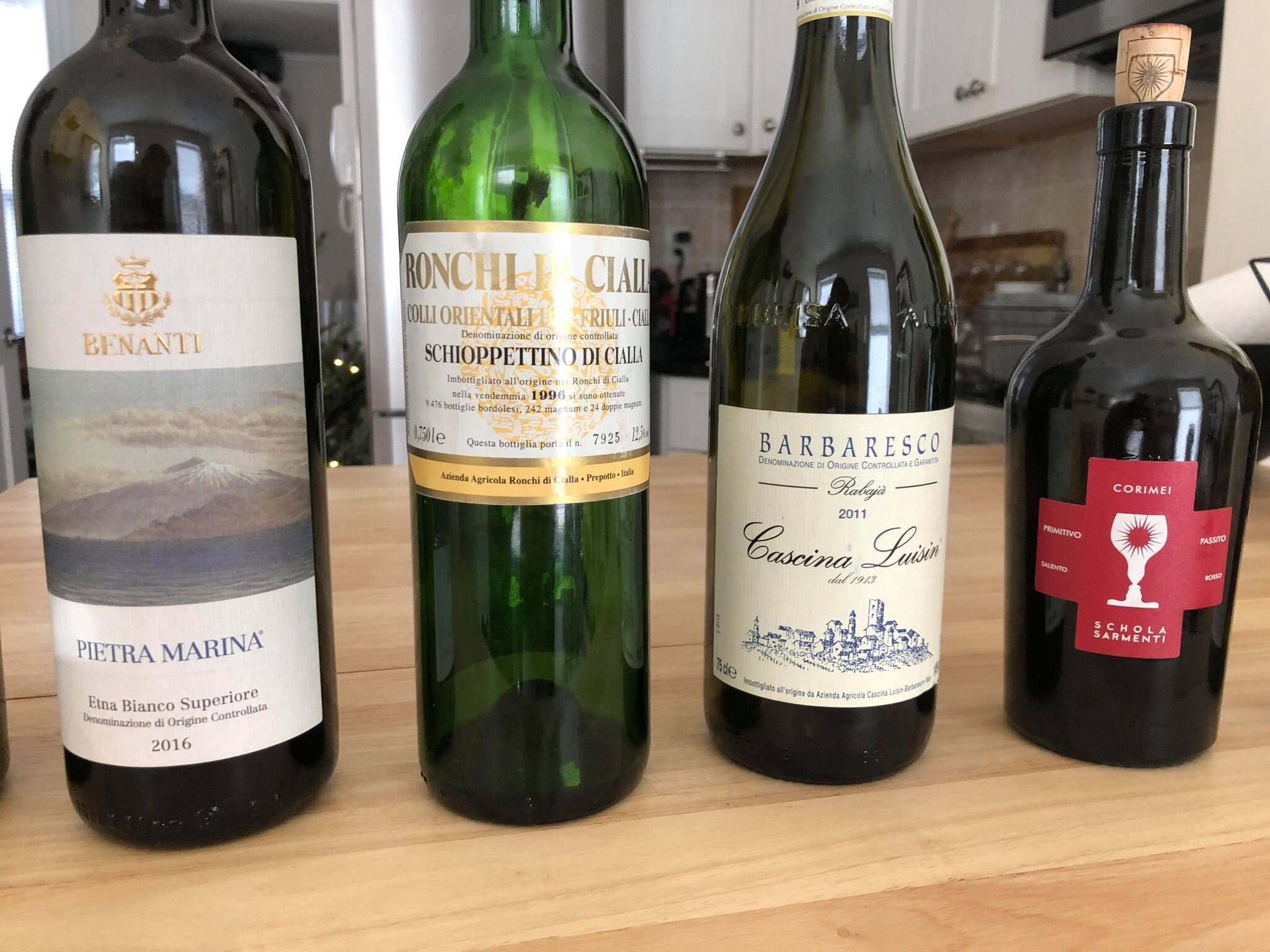The Press
We created The Press to house original content, as well as pertinent, interesting media from our friends and partners, exclusively for Pressoir Club Members.
Categories
What's Pressoir Cooking?
April 4, 2023
by Justine Puaud
Asparagus
A sure sign of spring
While asparagus is usually found year-round, like most produce, it has a peak season. Asparagus season usually starts around late February and goes until June, with the peak months in April and May, so I thought I would share a simple recipe with a mousseline sauce.
While I find delicious white asparagus in Beaune’s farmers market, I remember that in the U.S white asparagus are not common and you will more easily find green asparagus, equally good.
Green asparagus with mousseline sauce
Ingredients for 4 people
2 bunches of green asparagus
1 egg
1 handful of hazelnuts
5 sprigs of tarragon
5 sprigs of chervil
1 tablespoon of mustard (a strong Dijon mustard)
sunflower oil
salt and pepper
Instructions
Cut the base of the asparagus which is a little too woody. Rinse and cook them for about 4 to 5 minutes or until tender in a large pan of boiled salted water. Immediately rinse them under cold water to stop the cooking quickly or plunge in a bowl of ice water. Drain and let cool on absorbent paper.
Separate the white from the yolk of the egg. Whisk the yolk with mustard, salt and pepper, add the sunflower oil, until you get a nice mayonnaise consistency. Add the chopped herbs into the preparation.
Roast the hazelnuts in a dry pan for 2 minutes then crush them with a knife.
Whisk the egg white with a pinch of salt and gently fold it into the mayonnaise.
Serve asparagus topped with the mousseline sauce and sprinkled with crushed hazelnuts and voilà!
Many sommeliers will say asparagus and wines are not close friends but I think a crisp mineral Chardonnay like a Saint-Romain will pair perfectly with this recipe. I recently discovered Domaine Henri & Gilles Buisson and absolutely loved their Saint-Romain. “Sous la Velle”.
Did you know?
In Burgundy, you will find another variety of asparagus named “L’Asperge des Bois”. It looks like a small ear of almond green wheat. It is picked before it blooms, a pompom of white flowers. Most often wild asparagus grow in "bands", when there is one, there are plenty .. I particularly found it in a deciduous forest, in the undergrowth, towards the wet and shaded meadows. You can just cook it simply, roasted with olive oil and garlic.
WHAT'S PRESSOIR COOKING?
Victoire Chabert
March 15, 2023
A few more days of cold weather before the spring season... why not get a head start and start thinking about sunny recipes? Here is the recipe of a dish that my mother makes every year and that delights the tastebuds of many… and which I must now master to take over the tradition and heritage!
Ingredients for 4 persons :
4 tomatoes
100 g of white ham
100 g ground beef
100 g sausage meat
1 shallot
1 clove garlic
10 g butter
2 tbsp olive oil
1 egg
1 tbsp fresh cream
2 tablespoons of parsley and oregano
Salt, pepper and breadcrumbs
With a knife, cut off the top of the tomatoes (reserve the caps). Gently scoop out the tomatoes with a teaspoon, keeping the pulp removed: be careful not to pierce the tomatoes. Salt the bottom of the tomatoes and turn them over on a plate so that they give up their water.
Peel garlic and shallot. Chop the garlic after removing the germ. Finely chop the shallot. Drain the tomato pulp well to remove excess water and cut into small pieces.
Preheat the oven to 410 degrees F. Put the butter and 1 tablespoon of olive oil in a pan. Brown the shallots and garlic. Add the tomato pulp, sprinkle with parsley and oregano. Season with salt and pepper. Simmer over low heat until most of the liquid has evaporated (about 8 to 10 minutes).
Meanwhile, finely chop the white ham. Put it in a bowl with the ground beef and sausage meat. Add the garlic/shallot/tomato mixture and mix well. Add the whole egg and cream. Mix well. Season with salt and pepper if necessary.
Put this filling in the hollowed-out tomatoes and place them in a pre-oiled casserole. Cover tomatoes with their caps. Drizzle with 2 tablespoons olive oil and sprinkle with breadcrumbs. Place in the oven for about 45 minutes (if the top of the tomatoes becomes too brown, cover with aluminum foil to finish cooking). In your dish, add the rice between all your tomatoes and put it back in the oven for a few minutes to brown the rice and get the sauce’s taste.
Here is the classic recipe of the famous stuffed tomatoes but I love to have a dish with several vegetables like zucchini, onion or eggplant where you can follow the same instructions. I personally find the mix of tastes and flavors even better together.
What's Pressoir Cooking?
Truffle season
Eggs and truffle purée by Chef Jean-Michel Belin of Le Beauvallon Hotel in Provence
by Justine Puaud
January 18, 2023
We are in the middle of the truffle season. The famous truffle market is in Richerenches in France and is open from November to March every year. If you plan to visit the Provence region around this time of year, you have to make a stop there. It is not like a traditional farmer market. You enter a quiet street where there are a dozen mini vans and people will be selling truffles from the back of their cars…
The tuber melanosporum, also called black truffle, is quite strong on the palate. I tried many recipes with truffles and I think overall the simplest recipes are the best (omelette with truffle, pasta with truffle, French coquilles Saint-Jacques carpaccio) But, I have to say, the soft boiled egg with a truffle purée is among my favorites. The mix between truffle, béchamel sauce and madeira makes this recipe just delicious and really enhances the truffle.
Ingredients
12 fresh eggs
120g fresh truffle
30g béchamel sauce (if you don’t know how to make a béchamel, check out this recipe)
40 cl heavy cream
120g of butter
25 cl of madeira
25cl of truffle juice (buy a can of truffle juice from Plantin)
6 slices of bread (ie traditional baguette)
salt and pepper
Instructions
Sauce
Put the eggs and truffles in an airtight container in the refrigerator the night before.
Put the eggs in the blender to obtain a very fine purée or cut the truffle into very small pieces.
Make a béchamel.
Then, in the saucepan, reduce the Madeira and truffle juice to dryness, add the cream and the béchamel. Leave to cook for a few minutes, stirring.
Add the truffle purée and the béchamel to the Madeira and truffle juice and leave over low heat for 3 minutes.
Cook the eggs for 3 minutes in salted boiling water. Remove the egg from the shell, then using a teaspoon, remove the little white that is not cooked.
In a frying pan, brown the slices of bread with a little butter, then cut them into "mouillettes" and keep them warm.
It's almost ready to eat. Fill the egg cavity with the truffle purée, dip the bread in the egg with the sauce and enjoy.
What's Pressoir Cooking? Crispy Porchetta
by Max Goldberg Liu
Wednesday, January 11, 2023
by Max Goldberg Liu
January 11, 2023
Tasked with cooking the main course for a New Year’s Eve dinner party, I wanted to try something different than the typical prime rib or steaks that we usually spring for on special occasions. I’d always wanted to try making a porchetta, the savory rolled Italian pork roast that feeds a crowd - and then some. My go-to recipe source, Serious Eats, came through yet again with a dead-easy version of the dish that omits the often-dry pork shoulder component in favor of the pure succulence and fatty goodness of pork belly.
My local Whole Foods had slabs of rind-on pork belly that were around 12 inches wide, so I ended up making multiple porchettas. I deeply scored the meat-side and rubbed in a flavorful mixture of garlic, red pepper flakes, fresh thyme, ground fennel, and plenty of salt and pepper. Once rolled and tied, I rubbed the skin of each porchetta with a mixture of salt and baking powder which, Serious Eats tells us, lowers the PH of the skin and helps it get as crispy as possible, which definitely worked! After 24 hours in the fridge, the porchettas were ready to roast for 3 hours in a 275º oven, followed by around 25 minutes at 500º to put the final crisp on the skin.
This was seriously one of the best things I’ve ever cooked at home, and the ultra-crispy skin, super flavorful belly meat, and delectable fat made for an awesomely rich New Year’s Eve. We first paired it with a 2015 Barbaresco from Cantina di Glicine, whose acidity and tannin made for a great foil to the pork. A 2019 Côte-Rôtie from Clusel-Roch also paired quite well with it. And while ultimately we ended up hosting fewer people than expected at the dinner, it turns out that leftover porchetta also makes for great sandwiches!
I highly recommend giving this recipe a shot if you like crispy, fatty pork - I can’t overstate how easy it was to do.
All Belly Crispy Porchetta (from Serious eats)
Ingredients:
1 whole boneless, rind-on pork belly, about 12 to 15 pounds (5.4 to 6.8kg)
2 tablespoons whole black peppercorns
3 tablespoons whole fennel seeds
1 tablespoon crushed red pepper
3 tablespoons finely chopped rosemary, sage, or thyme leaves
12 cloves garlic, grated on a microplane grate
Kosher salt
2 teaspoons baking powder
Instructions:
Place pork belly skin-side down on a large cutting board. Using a sharp chef's knife, score flesh at an angle using strokes about 1-inch apart. Rotate knife 90 degrees and repeat to create a diamond pattern in the flesh.
Toast peppercorns and fennel seeds in a small skillet over medium-high heat until lightly browned and aromatic, about 2 minutes. Transfer to a mortar and pestle or spice grinder and grind until roughly crushed.
Season pork liberally with salt, then sprinkle with crushed pepper and fennel, red pepper, chopped herbs, and microplaned garlic. Use your hands to rub the mixture deeply into the cracks and crevices in the meat.
Roll belly into a tight log and push to top of cutting board, seam-side down. Cut 12 to 18 lengths of kitchen twine long enough to tie around the pork and lay them down in regular intervals along your cutting board, about 1-inch apart each. Lay rolled pork seam-side down on top of strings. Working from the outermost strings towards the center, tie up roast tightly. Combine 2 tablespoons kosher salt with 2 teaspoons baking powder. Rub mixture over entire surface of pork.
If roast is too large and unwieldy, carefully slice in half with a sharp chef's knife. Wrap tightly in plastic and refrigerate at least overnight and up to 3 days. If desired, porchetta can also be frozen at this point for future use (see notes).
Adjust an oven rack to the lower-middle position and preheat oven to 300°F (150°C). Place pork in a V-rack set in a large roasting pan, or if cooking both halves at the same time, on a wire rack set in a rimmed baking sheet. Place roasting pan in oven and roast until internal temperature of pork reaches 160°F (71°C), about 2 hours, basting with pan drippings every half hour. If you'd like to cook potatoes along with the porchetta, see note. Continue roasting until a knife or skewer inserted into the pork shows very little resistance asides from the outer layer of skin, about 2 hours longer.
Increase oven temperature to 500°F (260°C) and continue roasting until completely crisp and blistered, about 20 to 30 minutes longer. Alternatively, you can remove the roast from the oven and tent with foil for up to 2 hours before finishing it in a preheated 500°F oven.
Tent with foil and allow to rest for 15 minutes. Slice with a serrated knife into 1-inch thick disks and serve.
What's Pressoir Cooking?
Justine Puaud
August 10, 2022
Peach Season
Summer is the time to bake with beautiful fruits such as peaches, apricots and nectarines. I discovered Chef Yotam Ottolenghi’s cuisine a few years ago and today I recommend his lime and rosemary peach tart.
Delicious, fresh, fragrant and juicy – it is the perfect pie for summer. The peaches are marinated with rosemary, lime juice, and lime zest before being baked in puff pastry. This recipe is very easy to make. Just make sure you plan it ahead of time, as you will need to macerate the peaches for 1-2 hours before you can bake it.
Ingredients
200 g (1 packet) all-butter puff pastry
2 limes
60 g (⅓ cup) granulated sugar
5 large firm peaches stoned and cut into 0.5 cm (0.2 inches) slices
2 large sprigs rosemary, plus ½ tbsp picked leaves
1/4 tsp cornstarch
150 g (⅔ cups) creme fraiche
Instructions
Marinate the peaches
Cut peaches in half, remove stones, and cut 0.5 cm (0.2 inches) slices.
Peel one of the limes in 7 long strips and place strips in a large bowl. Add the sugar, the juice of one lime, the peach slices and rosemary sprigs. Stir and set aside to macerate for at least 1-2 hours.
Strain the peaches through a sieve straight into a small saucepan, and set aside the rosemary. You should end up with about 60ml (¼ cup) peach syrup. Try to leave as little juice as possible on the peaches.
Chop the rosemary you just removed from the syrup and set it aside.
Prepare the creme fraîche
Mix the grated zest and a teaspoon of sugar into the creme fraiche and refrigerate until ready to serve.
Bake
Preheat the oven to 180°C (355°F). On a lightly floured work surface, roll out the pastry just under 0.3-0.4 cm (0.1 inches) thick. Line a previously buttered 24 cm (9.5 inches) tart ring or pan with the pastry.
Arrange the strained peaches in the pastry and bake for 25 minutes on the bottom rack of the oven.
Prepare the syrup
While the tart is baking, whisk the cornstarch into the reserved peach syrup. Simmer over medium-high heat until it thickens to the consistency of honey (about two minutes), then pour over the peaches. Sprinkle the chopped rosemary leaves on top and return the galette to the oven for 15 minutes, until the pastry is golden-brown and the filling bubbly.
Serve
Remove from the oven and transfer immediately to a cooling rack. Leave to cool slightly, then zest a lime onto the tart, and serve with a bowl of the lime creme fraiche on the side.
What's Pressoir Cooking - Carotte Râpées
June 22, 2022
By Justine Puaud
Summer is here!
Carotte Râpées
From three-Michelin-star Chef Alain Passard
In the summer, I try to be innovative and find some delicious, fresh and easy recipes. This one is for Daniel Johnnes who is a huge fan of “carottes rapées”. He cannot go to France without eating this traditional/super easy appetizer. I hope he will try and will love it!
This recipe is from Chef Alain Passard. The 3-Michelin star chef is known for designing menus only with vegetables. Chef of the restaurant Arpège in Paris, he sublimates the plant world like a painter in his canvas. Fifteen years ago, at the turn of the millennium, Alain Passard began a radical change of his era. Goodbye veal, cow, pig... The chef decided to break with meat, marrying beets, celery and turnips for a second time, and manages two large vegetable gardens in Sarthe and Eure, to satisfy his desire. In the land of veal blanquette and coq au vin, this vegetable love song could seem very daring. He was at the time the precursor of a new trend, and when ecology, food scandals and awareness of animal suffering were not really important problems to face, he was pleading for the reasonable consumption of meat.
This recipe is known for the dressing. He created the “citronette” which is a vinaigrette made only with lime, honey and olive oil. This dressing is absolutely delicious.
Ingredients
7 carrots (I usually like to mix colors)
1 apple (I recommend the pink lady apple which is juicy, tart and crunchy)
a handful of hazelnuts
a handful of raisins
some fresh parsley
2 limes
honey
olive oil
salt and pepper
Instructions
Grated carrots “Carottes râpées”
peel and grate the carrots
roast and crush the hazelnuts
prepare a julienne with the apple
add carrots, hazelnuts, raisins, apple and fresh chopped parsley in a bowl
“Citronette” dressing
squeeze lime juice in a bowl
add a good pinch of salt (ideally choose the “fleur de sel” salt")
add 1 tablespoon of honey (would recommend a liquid acacia honey)
Mix everything together to find the perfect balance between the acidity of the lime and the sweetness of the honey. Then, add 5-6 tablespoons of olive oil and continue to mix. The texture of the dressing will start to be creamy and smooth.
What's Pressoir Cooking - Soupe au Pistou
by Victoire Chabert
Thursday, May 26
The traditional Pistou Soup
by Victoire Chabert
May 26, 2022
Today, I invite you to cook the real Soupe au Pistou to celebrate the beginning of summer. It is a great classic of traditional Provencale cuisine. It is a dish that we prepare all together and we enjoy it every year. An easy summer soup, with fresh summer vegetables delicious both hot and cold.
Here is the ancestral and almost secret recipe...
Ingredients for 6 people (we usually make a larger quantity so we can freeze it, it will be just as good)
600 grams (21 ounce) of white coco (white beans)
300 grams (10.5 ounces) of green beans
3 carrots
2 potatoes
2 zucchini
1 onion
2 tomatoes
Tomato concentrate
2 cloves of garlic
2 handfuls of small pasta like ‘coquillettes’
Herbs such as thyme and laurel
Salt and pepper
Grated or whole Parmesan cheese
For the Pistou sauce
6 cloves of garlic
80 mL (5.6 tbsp) olive oil
1 large bunch of basil
Salt and pepper
Instructions:
1- Hull the beans, peel all the vegetables, rinse and dice them and set aside. (Do it with your family or friends, it will be less time consuming and more convivial!)
2- In a pot, brown the onions in a little olive oil and add the tomato paste.
3- Place your beans, your coco, your carrots, your tomatoes, your herbs and the minced garlic and fill it up with water. Add salt and pepper.
4- Cover the pot and let it cook on low heat for about 45 minutes.
5- While everything is cooking, prepare the pistou with the garlic and basil in a blender and add the olive oil a little at a time to make it a creamy texture. I like to add a little grated Parmesan cheese to the Pistou sauce.
6- After 45 minutes of cooking the soup, add the potatoes and zucchini and a sprig of basil and simmer for another 20 minutes.
7- Put 1/3 of your Pistou in the pot and set it aside the rest for the finishing dressing. Also keep some of it to serve at the table.
8- 5 minutes before the end of the cooking time, add the pasta and continue to cook. Don't hesitate to taste each vegetable of your soup regularly to check the cooking.
9- Serve the soup, add the Pistou and the Parmesan cheese and enjoy.
In terms of wine, Pistou soup calls for a Côte-de-Provence rosé such as a Bandol or Cassis but you can be tempted by other combinations such as a light dry white or an Italian red!
What's Pressoir Cooking
April 11, 2022
by Justine Puaud
Pâté Lorrain
Pâté Lorrain is a French dish with marinated meat that is wrapped in puff pastry. In traditional French cuisine, the meat needs to be a mixture of pork and veal. The meat is sliced and marinated in a flavorful mixture of white wine, thyme, parsley, bay leaves, and shallots. It has to be completely enclosed in puff pastry before putting it in the oven. The dish is usually associated with Baccarat, a commune located in the Lorraine region, which, as you might have guessed, is the location of the celebrated Baccarat glassworks which can trace its existence back to 1764 when King Louis XV initiated its construction.
Ingredients
300 g of pork shoulder
300 g of veal
1 shallot
1/2 onion
1 bay leaf
3.5 oz or a small cup of white wine
1 tbsp. teaspoon of fine salt
600 g of puff pastry (it is really long and difficult to make puff pastry. I usually order it from the boulanger (the bakery)
1 egg yolk
1 tbsp. of milk for brushing on top
Instructions
The day before, chop the meat, cut the shallot and onion into medium pieces and put everything together in a salad bowl. Add the white wine, salt, bay leaf, mix well and reserve the preparation, covered, for 12 hours in the refrigerator.
The next day, roll out the puff pastry into a rectangle of 12 x 8” on each side and 2 mm or 1/4” thick. Drain the stuffing, remove the herbs and arrange it in a strip 4 inches wide by 8 inches long in the center of the rectangle of dough.
Fold the long sides of the dough over the stuffing, then fold the short sides. With the rest of the dough, make a rectangular pastry and place it on top of the pâté (blend the 2 doughs together by moistening them with water). Brush the pastry with beaten egg yolk and milk.
Leave the pâté for 20 to 30 minutes in the refrigerator so that the dough firms up in order to make a nice incision with a knife for decoration.
Bake the pate in a preheated oven at 350°F. Count about 55 minutes of cooking.
The best way to serve this French classic is warm or chilled, with a green salad on the side.
For the wine, I will recommend a Pinot Noir from Alsace - close to the Lorraine region.
Bon appétit!
What's Pressoir Cooking?
by Victoire Chabert
March 24, 2022
Gnocchi
Italian gnocchi is a real family affair. In this case, my father’s side of the family is from the South of France which historically shares many cultural aspects with Italy. (My mother's family is from Meursault, whose recipes I will be happy to share with you soon, stay tuned!). I remember, when I was very young, going to my grandparents' house on dark winter days to help my grandmother make the gnocchi that everyone loved. Indeed, she needed little hands to help her make every single gnocchi and that could get the hang of the technique with the fork. You will see in the recipe exactly what I am talking about. Through that repetition, this age-old Italian recipe has become my specialty. Allow me to share the secrets with you...
Ingredients for 4 people
1kg (2.20 lbs) of potatoes (ideally an earthy type)
800g (1.76 lbs) flour
2 eggs
Pinch of salt and pepper
100g (0.2 lb) butter
Materials
Puree press
Spatula
Saucepan
Skimmer
Salad bowl
Large plank
Preparation for the Gnocchi
Put your unpeeled potatoes in a large saucepan, cover with cold water, bring to a boil, add a handful of coarse salt, lower the heat and cook at a gentle simmer for about 30 minutes. Check the cooking with the tip of a knife.
Once cooked, don't wait too long before peeling the potatoes, as the dough must remain hot as long as possible to form the gnocchi. In a bowl, mash them with a potato masher.
Gradually add the flour, and eggs, butter, pinch of fine salt and pepper. Start mixing with a spatula, then knead by hand until all the elements are well combined and the dough is smooth. Form a ball and flour your work surface. Be careful, the recipe says 800 g of flour but you may need more or less, depending on the water content of the potatoes. Work your dough for a few minutes but not too long.
Once your dough is ready, cut into a first piece and form a long snake (see photo) and cut your gnocchi to about 2.5 cm (1 Inch) each.
Place each gnocchi on the tines of a fork. Press lightly in the center with your thumb, to create a hollow. It's not that easy at first, but you'll soon get the hang of it. Place your gnocchi on one or more boards, making sure to leave them all flat. You don't want to end up with a big ball of gnocchi sticking together. You can let them rest for a few hours in the fridge or in the open air covered with a dishcloth.
When ready to serve, boil some water in a saucepan and add a pinch of salt. Drop your gnocchi in it and after a few seconds they will rise to the surface, which means they are cooked. Using the skimmer, pick them up and place them on your serving dish. Add the sauce of your choice. My favorite is the Daube sauce (see recipe below) with grated cheese on top but they are also excellent with a tomato basil sauce, pesto or cheese sauce.
For the Daube sauce
Cut up pieces of beef (bourguignon) , flour them and fry them in hot oil with minced onion. Add garlic, some sliced carrots and mushrooms if you like. Season and add a bottle of red wine. There is no need to add a good wine... save the good ones for dinner! You can add a vegetable stock cube and some thyme leaves. Cook gently for 3 hours. It's so good. You can actually use this sauce for gnocchi as well as pastas, raviolis… anything you want.
Bon appetit !
What's Pressoir Cooking
Justine’s husband cooks his famous Blanquette de Veau for the team
February 18, 2022
by Justine Puaud
The famous blanquette de veau
A traditional French veal stew
Edouard and Daniel spent this week in Burgundy visiting winemakers in the Côte de Beaune and Côte de Nuits and tasting the fantastic 2020 vintage. For their last evening in Burgundy, they came to my place and had the privilege to eat my husband’s “madeleine de Proust”* - blanquette de veau.
We were lucky to have two young winemakers with us - Camille Thiriet and Thibaud Clerget. Camille is a passionate and talented winemaker who started to make wine in a garage in 2016. She now produces fantastic red and white wines from the Côte de Nuits. Thibaud of Domaine Yvon Clerget is based in Volnay. Antonio Galloni has said “the reborn Domaine Y. Clerget could very well turn out to be one of the great recent success stories in Burgundy”, so bravo to Thibaud!
*’La madeleine de Proust’ is a French expression used to describe smells, tastes, sounds or any sensations reminding one of childhood or simply bringing back emotional memories from a long time ago.
The origin of the term “blanquette” comes from the color of the white sauce that coats the stew meat.
Ingredients for 6 people
1 liter of cooking white wine
2 lbs veal , shoulder, chest or flank, cut into large cubes
1 onion , poked with whole cloves
1 bouquet garni (parsley, thyme, bay leaf, sage)
4 carrots , cut into large sections
1 cup dry white wine
10 oz. mushrooms , quartered
4 tablespoons butter
½ cup flour
¾ cup creme fraiche
½ lemon , juiced
3 egg yolks
Instructions
Put the meat cubes in a large saucepan and cover with cold water. Bring to a boil and add salt.
Skim regularly at the surface so that the broth becomes clear. After 20 minutes, add the onion stuck with cloves and the bouquet garni.
Simmer for another 20 minutes, then add carrots and wine.
Continue to simmer uncovered over low heat for another 45 minutes or until meat is tender. Add a little water during cooking if necessary. Remove the onion and the bouquet garni.
Meanwhile, sauté the mushrooms in a frying pan for 2 minutes with a knob of butter. Add salt, pepper, a ladle of broth and continue cooking for 5 minutes.
Sauce (prepare a few minutes before serving).
In a saucepan, melt the butter. Add the flour while whisking over low heat for 5 minutes.
Gradually add cooking broth while whisking until a reaching a thick sauce consistency.
Add creme fraiche as well as lemon juice, and continue cooking for 2 minutes.
Take saucepan off the heat and add egg yolks. Whisk well to incorporate. Add this sauce back to the pan with the meat and vegetables. Add the mushrooms and gently stir to incorporate everything.
Immediately serve the blanquette with rice.
Wine pairing
We opened a few Pinot Noirs and finished with a Nebbiollo. 2019 is a really promising vintage. It is fresh and juicy. I really enjoyed the Chassagne Premier Cru “Clos de la Boudriotte” rouge from Domaine Ramonet. It smells of black fruit, boosted with an almost spiced note. Its fruit is pure and intense with a powerful tannic structure that firms up the finish.
What's Pressoir Cooking?
January 5, 2022
by Justine Puaud
Wild boar tournedos with pears in spicy wine sauce
I haven’t spent Christmas in France with my family for the last 7 years. This year was kind of special as we were celebrating the first Christmas with my daughter Fleur and it also announced our official return to our home in France!
My in-laws are definitely the biggest food lovers and food connoisseurs I know. My mother-in-law spends her whole day in the kitchen, making fantastic slow cooked dishes, traditional French pastries and incredible sauces. She loves to cook wild boar around the holidays. This is a tradition in her family. I am often a bit nervous because in my opinion, wild boar tends to be too strong and rich in flavor. This time I was wrong. The wild boar tournedos were tender and delicious. The pear brings freshness to this heavy, creamy sauce.
For this occasion, we opened Château Giscours, Margaux 2001 and Roc D’Anglade 2011. Giscours was delicious and was representative of the great Bordeaux, with soft tannins. It took a while for the Roc d’Anglade to open. There was a delicate truffle nose and a fine and fresh palate.
Ingredients for 6
6 wild boar tournedos
12 slices bacon
6 pears
1 btl red wine (the sauce is really important in this dish so you MUST select a good wine)
2 star anise
1 cinnamon stick
black pepper seeds
1 cup of cream
5 ounces of butter
3 ounces of sugar
4 teaspoons of crème de cassis (blackcurrant liquor)
1 piece of dark chocolate
salt & pepper
Pears
Peel pears and core them. Gently heat the wine with spices and sugar. Plunge pears - to poach them - in this liquid for about 15 minutes over low heat. Leave pears in the poaching wine and macerate for two hours. Then drain pears. Surround each pear with a slice of bacon, place them in a gratin dish with butter and bake them for about 15 minutes (410F).
Sauce
Keep the maceration wine from the pear preparation and reduce to three quarters over medium heat for about 45 minutes. Once the wine is reduced, add whipped cream, black currant liquer and the piece of chocolate. Season with salt and pepper, then filter the preparation. Return the pan to low heat. Boil the whole mixture into a thick sauce, adding butter in small pieces while whisking.
Meat
Wrap each tournedo with a slice of bacon and tie up. Heat a knob of butter in a pan and quickly sear the tournedos on all sides including the sides. Turn off heat, put a lid on the pan and let stand for 1 minute. On each plate, put one pear, a tournedo and cover with the sauce.
It is delicious! Bon appétit.
What's Pressoir Cooking? Choucroute Garnie
by Max Goldberg Liu
December 8, 2021
For those of you who don’t know, Edouard somewhat famously has a healthy obsession with Bœuf Bourguignon - the beef stew that is definitely in the top 5 of French comfort food. This involves frequently ordering the dish at restaurants, debating the pros and cons of different variations, and holding strong opinions on what constitutes a proper bœuf bourguignon and what does not.
I, in turn, have my own obsession with Choucroute Garnie, a dish that I believe is somewhat less associated with French cuisine here in the US but which, despite its regional origins, can now be found in nearly every corner of France.
Directly translating to “dressed sauerkraut,” Choucroute Garnie is essentially a plate of hot sauerkraut that has been warmed with aromatics and spices, topped with a variety of meats, and served with a side of potatoes.
Choucroute might seem out of place in French gastronomy, but it is said that the dish came from Eastern/Central Europe. Major areas of the Germanic regions of Alsace and Lorraine became part of France following the 1648 Treaty of Westphalia, that ended a long period of violence and devastation in Europe caused by the Thirty Years War and Eighty Years War.
While this would certainly not be the last time that Alsace and Lorraine would change hands until the modern day, the regional cuisines would remain firmly entrenched in French culture, particularly in the grand Brasseries, two of which make a particularly good choucroute: Brasserie Lipp in Paris’ 6th Arrondissement, where the dish is crowned with a mammoth glistening pork shank, and Brasserie Georges in Lyon opposite the Gare Perrache, whose massive portion (le plateau de choucroute) with sausages, pork belly, and pork loin can easily feed two (or just one hungry traveler…).
There are not many restaurants, unfortunately, here in New York that serve choucroute, so upon a recent craving, I took it upon myself to try to recreate it at home, which was somewhat easier than expected.
It’s really as simple as braising some high quality sauerkraut with onions, white wine, a little stock, garlic, juniper berries, caraway seeds, cloves, and bay leaf, and topping that with your preferred meats and some boiled potatoes. You can braise the meats with the kraut if you’d like but I thought this quick version was nearly as good. I kept things judicious with only some Schaller & Weber frankfurters and a roasted pork loin but you can go as big or as small as you’d like. Please just avoid Choucroute de la Mer if possible - I am a choucroute purist and believe that fish has no place in a proper choucroute!
The classic wine pairing is an Alsatian white like Riesling, Pinot Gris, Pinot Blanc, or even Gewurtztraminer but it pairs wonderfully with any relatively dry white that isn’t too rich.
Choucroute Garnie Rapide
1 lb boneless pork loin
Kosher salt
3 tablespoons vegetable oil (or lard/duck fat)
1 medium yellow onion
1 cup dry white wine
1/2 cup chicken stock
1 tied bouquet garnie of 2 crushed garlic cloves, 5-10 dried juniper berries, 1 clove, 1/4 teaspoon caraway seed, 1 bay leaf
2 lbs good quality sauerkraut, drained
1 package natural casing frankfurters (Schaller & Weber makes a great one)
3-5 small Yukon gold potatoes, peeled, halved or quartered, and simmered in salted water until tender
Up to 48 hrs before cooking, generously season the pork loin on all sides and keep refrigerated on a wire rack set over a rimmed baking sheet
Preheat oven to 250º-300ºF (depending on how well your oven can hold low temperatures). Cook the pork loin in the oven until an instant read thermometer reads 120ºF, around 1 hr. Set aside
In a large dutch oven, heat the oil or fat until shimmering. Add onions and cook until soft but not brown.
Meanwhile, in a colander, lightly rinse the sauerkraut to your desired level of tang, if necessary.
Add wine, bouquet garni of aromatics, and stock to the onions, stir, and cook over medium-high heat for 2 minutes.
Add sauerkraut, stir to combine, and lower heat to a bare simmer. Cover and cook for 30 minutes or until much of the liquid has been absorbed and the sauerkraut is deeply aromatic.
Preheat a cast iron pan over high heat with neutral oil. Quickly sear all sides of the reserved pork loin and sear, turning until well browned on all sides.
Fill a large saucepan with water and bring to a simmer over medium-high heat. Add the frankfurters and simmer until heated through. Remove and keep warm.
Season the sauerkraut with salt to your desired level. Place a heaping amount on a warm plate, add 1-2 sausages, 2-3 slices of pork, and a few pieces of potato. Serve with strong Dijon mustard and white wine like Chablis or a dry Alsatian Riesling or Pinot Gris.
What's Pressoir Cooking?
What’s Pressoir Cooking
By Edouard
8/17/21
Herb Crusted Rack of Lamb AND Traditional Provencal Ratatouille
Recipes largely inspired by Serious Eats
Edouard Bourgeois
August 17, 2021
Love it or hate it, lamb meat certainly polarizes meat eaters with its particular flavor that some consider too gamey, or “lamby”. I love lamb and this preparation is a recipe I learned while in culinary school back in the early 2000’s.
The idea simply consists of making a crust that will gently infuse through the meat while roasting in the oven or grilled in a covered barbecue. That crust is easy to make and is a mix of bread crumbs, butter, herbs, mustard, salt and pepper. It takes a few tries to master the perfect ratio between the butter and the breadcrumbs so the crust is neither too dry nor too fatty but the result is delicious.
I like to make a simple garnish that is vegetable based, with bright flavors of summer to contrast the rich meat preparation. For that, nothing is more appropriate than the classic ratatouille.
FOR THE LAMB:
1 cup fresh bread crumbs
2 tablespoons finely chopped fresh flat-leaf parsley
2 teaspoons finely chopped fresh mint
1 teaspoon minced fresh rosemary
1 teaspoon salt, divided
1 teaspoon black pepper, divided
1 stick butter, room temperature
2 frenched 7-10 rib racks of lamb, trimmed of all but a thin layer of fat, about 1.5 - 2 pounds each
2 tablespoons Dijon mustard
DIRECTIONS:
Mix the bread crumbs, parsley, mint, rosemary, 1/2 teaspoon salt, and 1/2 teaspoon pepper and soft butter (not melted) together in a small bowl until homogeneous.
Spread that paste between 2 sheets of baking paper to form a crust 1/4 inch thick.
Store it in the freezer, still with the baking paper overnight. The next day, take out the crust, now solidified and cut out a piece that match the shape of the lamb rack
Let the lamb come to room temperature while preparing the grill. Light one chimney full of charcoal. When all the charcoal is lit and covered with gray ash, pour out and arrange the coals on one side of the charcoal grate. Set cooking grate in place, cover grill and allow to preheat for 5 minutes. Clean and oil the grilling grate. Season the racks liberally with salt and pepper. Place the lamb fat side down close to but not directly over the coals. Cover and grill until well browned, about 8 minutes, rotating 180 degrees half way through. Remove racks from the grill and place fat side up on a platter or cutting board.
Spread the mustard over the fat side of the lamb. Carefully press the breadcrumb mixture into the mustard on each rack.
Place the racks back on the grill, fat side up, close to, but not directly over the coals. Continue to cook until an instant read thermometer registers 130 degrees when inserted into the side of the rack, another 8 to 10 minutes. Remove from the grill and let rest uncovered for 10 minutes. Cut between each rib into chops and serve.
FOR THE RATATOUILLE:
3 cups 1/4-inch diced summer squash, such as zucchini and yellow squash (about 4 small or 2 medium squash)
3 cups 1/4-inch diced Italian eggplant (about 1 medium eggplant)
Kosher salt and freshly ground black pepper
3/4 cup (12 tablespoons) extra-virgin olive oil, divided, plus more as needed
3 cups 1/4-inch diced yellow onion (about 3 medium onions)
6 medium cloves garlic, minced (about 2 tablespoons)
3 cups 1/4-inch diced red and yellow bell pepper (about 4 large peppers)
2 cups pureed canned whole tomatoes, with their juices, from 1 (28-ounce) can (see note)
1 bouquet garni (herb bundle), made from fresh herbs such as thyme, parsley, and basil, tied together with butcher's twine (see note)
Chopped fresh parsley leaves and tender stems, for garnish (optional)
DIRECTIONS:
Place summer squash in a wire mesh strainer set over a bowl; place eggplant in a second wire mesh strainer and set over a second bowl. Toss both with a liberal amount of kosher salt and let stand to drain at least 15 minutes and up to 1 hour. Discard any liquid that collects in the bowls.
In a large skillet, heat 3 tablespoons olive oil over medium-high heat until shimmering. Add onion and garlic, season with salt, and cook, stirring, until softened, about 6 minutes. Scrape onion and garlic onto a rimmed baking sheet and spread in an even layer to cool for 3 minutes. Transfer onion and garlic to a large pot.
Meanwhile, add 3 more tablespoons olive oil to skillet and heat over medium-high heat until shimmering. Add bell pepper, season with salt, and cook, stirring, until softened, about 7 minutes. Scrape bell pepper onto the rimmed baking sheet in an even layer to cool for 3 minutes. Transfer bell pepper to pot with onion.
Add 3 more tablespoons olive oil to skillet and heat over medium-high heat until shimmering. Add summer squash and cook, stirring, until softened, about 4 minutes. Scrape onto rimmed baking sheet in an even layer to cool for 3 minutes. Transfer to pot with onion and bell pepper.
Add remaining 3 tablespoons olive oil to skillet and heat over medium-high heat until shimmering. Add eggplant and cook, stirring, until softened, about 4 minutes; add more olive oil as needed if skillet dries out while cooking eggplant. Scrape eggplant into pot with other vegetables and stir to combine.
Set pot of vegetables over medium-high heat and stir in tomato puree and herb bundle; heat until ratatouille is gently bubbling, then lower heat to medium and cook, stirring, until tomato puree coats vegetables in a thick sauce, about 15 minutes. Discard herb bundle. Season with salt, stir in chopped parsley (if using), and drizzle with a small amount of fresh extra-virgin olive oil. Serve right away, or chill and serve either reheated, slightly chilled, or at room temperature.
This dish is as beautiful as it is delicious.
What's Pressoir Cooking?
What’s Pressoir Drinking
Grilled Chicken Skewers
By Edouard
Ginger Honey Chicken Skewers
Recipe courtesy of Food Siblings Kitchen
Here is a simple recipe yet perfect crowd pleaser for a summer party in your backyard. Grilling marinated food is one of my favorite things to do. I particularly enjoy the combination of the charred flavor with the accent of citrus and ginger in that dish, and it makes it super fun to pair with wine.
My favorite associations:
Champagne Marie Courtin Resonance Extra-Brut (Delicious Blanc de Noirs with energy and depth)
Occhipinti Il Frappato 2014 (I’ve always liked Sicilian wines and the reds from the Frappato can be very pure and fresh. Occhipinti is certainly a reference and 2014 a terrific vintage)
INGREDIENTS (4-6 servings)
3 medium cloves garlic, minced
6 tablespoons extra-virgin olive oil
2 lbs. of boneless, skinless chicken thighs (or breasts)
1 lemon, zested and juiced
1/2 inch of fresh ginger, grated
1 teaspoon honey
salt and pepper
1 pint cherry tomatoes
1/4 cup fresh basil, finely chopped
1/4 fresh parsley, finely chopped
1 tablespoon rice wine vinegar
PROCEDURE
Set half the burners on a gas grill to medium heat setting, cover, and preheat for 10
minutes. If using bamboo skewers, set in a large baking dish enough to cover skewers
with water and let soak. While grill preheats, whisk together garlic, oil, lemon zest and
juice, ginger, honey, salt and pepper in a large bowl. Prick chicken all over with a fork,
then cut into 2-inch chunks. Add to marinade and mix to coat. Let sit for about 5
minutes. While chicken marinates, combine basil, parsley, olive oil, vinegar, a large
pinch of salt, and a few grinds of black pepper in the bowl. Set aside.
Thread tomatoes onto soaked bamboo skewers, brush with olive oil, and sprinkle with a
little salt. Thread chicken onto metal (or pre-soaked bamboo) skewers. Make sure to
leave a little room between pieces on the skewers so they cook evenly.
Grill chicken and tomatoes over direct heat until tomatoes are softened and chicken is
lightly charred and cooked through, turning skewers occasionally, about 5 minutes for
tomatoes and 10 minutes for chicken.
Transfer chicken and tomato skewers to a platter and serve with herb drizzle.
What's Pressoir Cooking?
Saumon a l’Oseille
By Edouard
6/1/2021
Saumon a l’Oseille
I arrived in France last week and we are staying at my mom’s country home in Northern Burgundy. I love that bucolic atmosphere, far from the concrete jungle of Manhattan. It’s a refreshing feeling to reconnect with nature and I rediscovered the joy of picking my own fruits and vegetables in the orchard. One morning I was sampling some radishes with my son while checking on the growth of the snap peas and lettuces when I stumbled upon a massive bush of sorrel. That tangy herb is a great ingredient for soup or even an omelette but it was made famous by Chefs Pierre & Jean Troisgros in the classic recipe “saumon à l’oseille”.
So the next morning I picked a handful of those beautiful green leaves and started cooking. The association of the tangy flavor of sorrel and the fattiness of the salmon is excellent. Cream and butter are obviously key ingredients - the recipe calls for 4.5 oz of butter for 2 lbs of salmon...
You can cook the fish “en papillote” in parchment paper but I prefer grilling it over wood charcoal and preparing the sauce on the side. The smoky flavor is fantastic and you get a nice crisp skin while the center of the fish remains juicy and barely cooked.
As far as wine pairing, it may come as a surprise (since my mom lives close to the Chablis vineyards) but I opened a white Bordeaux that paired beautifully with the dish. The Sauvignon blanc grassy profile matched the sorrel and the wine, being so dry, offered a great contrast to the rich and creamy sauce.
A nice patch of sorrel (oseille in French)
RECIPE FOR 4-6 PEOPLE
2 lbs of salmon filet
4.5 oz of butter
2.5 oz of shallots
7 fl oz of cream
7 fl oz of dry white wine
4 fl oz of fish stock
1 fl oz of dry vermouth
1/4 cup packed sorrel
1/2 a lemon
Salt
Fresh cracked pepper
INSTRUCTIONS
Mince the shallots and put them in a sauce pan with white wine, fish stock and vermouth. Reduce slowly.
Add the cream and reduce more.
Add the sorrel leaves and wait 20 seconds. Remove the pan from the fire and add the butter in small pieces while gently stirring. Don’t use a whisk so the leaves don’t break
Add a dash of lemon juice, season to taste
Grill the salmon on a very hot grill so the skin gets crispy.
Pour the sauce in a deep plate. Place the pieces of salmon on top
Bon appétit!
What's Pressoir Cooking?
What’s Pressoir Cooking
By Edouard
3/9/2021
In my household, we all love Mexican inspired cuisine. The food is simply delicious, with snappy acidity, complex spices and I just can’t get enough cilantro…
Although a Margarita is certainly an obvious option for this chicken recipe, I really believe in pairing white Burgundy with this dish. Preferably a young Meursault whose crisp acidity kind of matches the accents of lime. I also like to think of the saline minerality in the wine that almost works as an extinguisher against the heat from the peppers.
Green Chili Chicken
ingredients
4 pounds boneless skinless chicken thighs
5 tomatillos quartered, husks discarded
2 Poblano peppers, roughly chopped, seeds and stems discarded
2 Anaheim or Cubanelle peppers roughly chopped, seeds and stems discarded
1 jalapeño, roughly chopped, stems discarded
1 medium white onion, roughly chopped
6 medium cloves garlic, peeled
1 tsp cumin
Kosher salt
1/2 cup loosely packed fresh cilantro leaves and fine stems, plus more for garnish
Fresh corn tortillas and lime wedges, for serving
Procedure
In an instant pot or traditional pressure cooker, combine chicken thighs, tomatillos, Poblanos, Anaheims, jalapenos, onion, garlic, and cumin. Heat over high heat until gently sizzling, then seal the pressure cooker, bring to high pressure, and cook for 30 minutes. Release pressure. Using tongs, transfer chicken pieces out to a bowl and set aside. Add cilantro to the remaining contents of the pressure cooker. Blend with an immersion blender or in a countertop blender, then season to taste with salt. Pull chicken with a fork and return to sauce. Stir gently to combine. Serve immediately with tortillas and lime wedges.
What's Pressoir Cooking? Poon Choi for Lunar New Year
by Max Goldberg Liu
Wednesday, February 17, 2021
This is a memory from a Lunar New Year I spent a few years ago in Hong Kong with my father’s side of the family but I find it appropriate to reflect on today!
Lunar New Year is a time to return home and spend time with family. Among the many banquets and feasts we enjoyed during our two weeks in Hong Kong was a meal at home where the centerpiece was a magnificent Poon Choi.
Literally translating to “basin-vegetable,” the apocryphal story of Poon Choi is that the Emperor of China in the late Song Dynasty fled south from Mongol troops to what is now the Guangdong region.
To feed the Emperor (and in some stories his entire army), the locals gathered the most expensive ingredients they could muster and cooked them all together. This means that, despite the name, Poon Choi ironically has a very low vegetable to meat/seafood ratio, though this is not uncommon in Cantonese cuisine!
The size of the dish means that Poon Choi is usually served during special occasions where there can be a lot of people on hand to finish the copious amount of food.
Like so many of the world’s tastiest dishes, Poon Choi is not particularly attractive, and it would seem that all the ingredients put together would not be greater than the sum of their parts but somehow it works beautifully.
Manners dictate that the Poon Choi is eaten in layers, with the more delicate ingredients at the top, like prawns, abalone, poached chicken, and king mushrooms, with braised pork belly, char siu, roast duck, fish balls, rehydrated mushrooms in the middle. The prized bottom layer is the beneficiary of all the sauce and juices that slowly make their way down, with cubes of Chinese radish that absorb all the flavors being the most fought-over delicacy.
The panoply of ingredients makes this somewhat tricky for wine but for me the best pairing of the night was a Saumur Rouge whose peppery flavors and bright acidity made for a reasonably good foil.
Poon Choi is a potent symbol of the communal power of dining together at the table, and we all hope that next Lunar New Year we will be able to share one together!
Happy Year of the Ox and Gong Hei Fat Choi!
What's Pressoir Cooking?
by Edouard
2/4/2021
Making Boeuf Bourguignon, in Burgundy!
Boeuf Bourguignon, le grand classique
Whenever I go visit my favorite producers in Burgundy, I make a pilgrimage to restaurant “Ma Cuisine” in Beaune to taste the famous regional “Boeuf Bourguignon”, a stewed dish made with a rich Burgundy wine sauce. This year, since all the restaurants were closed, Raj and I were delighted to taste Daniel’s (yes, Johnnes) interpretation of this superb, classic dish.
Although it is a countryside, somewhat rustic dish, details do matter, starting with the choice of meat.
Meat that has lots of collagen in it starts off tough (as it tends to come from the strongest parts of an animal's body) but, as it cooks, it very slowly transforms into meltingly soft and moist gelatin. It's that gelatin that makes the meat still seem moist even after the muscle fibers have inevitably dried out from long cooking.
A boneless chuck roll, which comes from the cow's incredibly strong shoulder, is perfect for stewing.
Of course, the wine you use matters too. Even though you may think the rich sauce will benefit from a powerful wine, it is actually the acidity in the wine that provides brightness to the dish. In our case, Bourgogne Passetoutgrain, a delicate fruity Burgundy made from a blend of Pinot Noir and Gamay really did the trick.
And for an added tip, add a touch of powdered cocoa powder for extra depth in the sauce…
Bon appétit, et santé!
What's Pressoir Cooking? Latkes (better late than never)
by Max Goldberg Liu
Wednesday, January 13, 2021
by Max Goldberg Liu
Wednesday, January 13, 2020
Hannukah is a favorite time of year for my family, and while we were not able to gather over the holiday itself this year, we got together after the new year to make latkes, a family favorite.
There are two schools of thought on latke preparation revolving around the form of the potato. The other ingredients remain the same - onion, matzoh meal, egg, and salt.
As far as I know, the “traditional” method involves basically whirring everything together in a food processor to make a sort of paste that is then shallow-fried. Simple and delicious.
The other method, which I asked my family to try out a few years ago, uses shredded potato and the result is similar to a swiss rösti. It is more elegant but in my opinion refinement isn’t everything with latkes.
I have never been an apple sauce person (alone, yes, but not with latkes) - instead, we order a variety of fish and roe from Russ and Daughters and use the latkes as a vehicle. A hot crispy latke with sour cream and salmon roe or caviar is a perfect bite, especially with a glass of Blanc de Blancs Champagne!
A “traditional” latke with an appropriate amount of salmon roe
The shredded version
What's Pressoir Cooking?
December 16, 2020
by Justine Puaud
Italian feast!
Last weekend, we had a Christmas dinner with my wine loving friends. We love to pick a theme and this time we decided to head to Italy! We cooked for about 4 hours in my friend’s tiny kitchen and prepared wonderful dishes.
The menu:
Aperitif : Focaccia with burrata and French porcini mushrooms
Appetizer: Homemade ravioli filled with ricotta and parmesan, grated black truffle
Main course: Osso Buco with Milanese Risotto and Gremolata
Cheese (you know I’m French…)
Dessert: Traditional Tiramisu
For those who don’t know, gremolata is a green sauce made of chopped parsley, lemon zest, and garlic. It is the standard accompaniment to the Milanese braised veal shank dish ossobuco alla milanese. We changed the recipe a little bit and added some olive oil. It was my first time with gremolata and I have to say it really balanced the dish and brought a lot of freshness without adding too much acidity.
For the Osso Buco, we used Chef Ludo Lefebvre’s recipe. If you get big veal shanks like we did, I recommend that you cook the dish for 3 hours and not 2 hours.
We paired this traditional Milanese dish with a Ronchi di Cialla 1996 wine made with 100% Schioppettino, an indigenous grape variety located in the region of Friuli-Venezia Giulia. It was superb! There was an elegant bouquet of spicy notes mixed with soft fruit aromas. The 1996 vintage was a good year in the Cialla area, perhaps slightly warmer and drier than usual.





